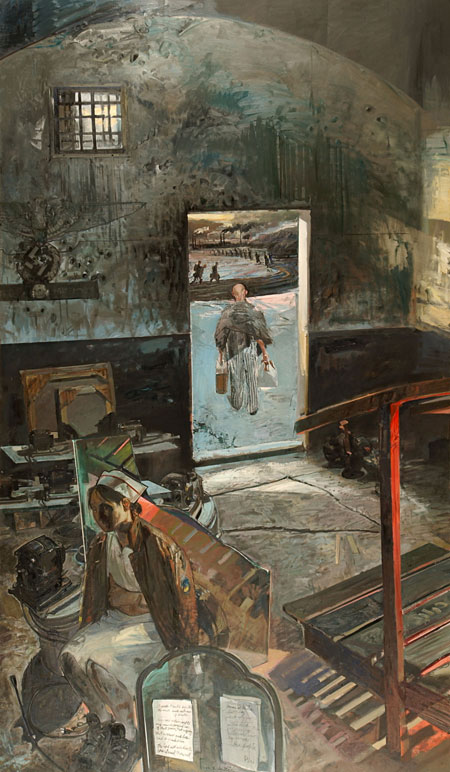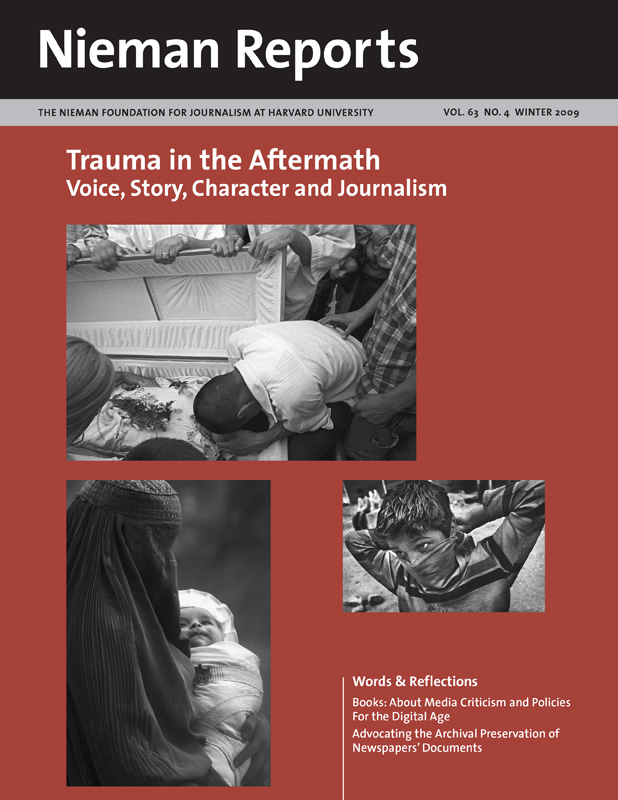
"Entering Darkness" by E. Ann KaplanE. Ann Kaplan is a distinguished professor of English and comparative literary and cultural studies at Stony Brook University. A literary and film scholar, she has written several books and papers about how trauma is portrayed in various media, including “Trauma Culture: The Politics of Terror and Loss in Media and Literature.” In this presentation her focus was on “art that addresses the ethical and aesthetic challenges of representing trauma.” In opening her remarks, she asked, “If trauma is not cognitively accessible or available in memory, how can we make art about it?” She observed that the artistic process of representing trauma is about “finding ways to preserve its horror while organizing the aesthetic experience so that spectators can take it in and grow from what is shown.”
The difficulty lies in finding aesthetic strategies appropriate to constructing a position for the viewer—and this is very important—that enables the viewer to take responsibility, and secondly, for creating a witness where there was none before. Yet in some representations of trauma there is a danger of what I call “empty empathy.” On the other hand, there is the danger of sensationalizing trauma so that audiences are vicariously traumatized—that is, they experience secondary trauma—and turn away in shock. So if the danger is what one critic calls “unwanted beauty” in works dealing with catastrophes, then trivializing through a too-easy aesthetic access is another.
In some works of art one finds an element of trauma’s elusiveness and subversion of reality. These works arguably position the viewer as a witness to trauma in an elusive, disturbing, perhaps haunting way, but nevertheless provoke in the viewer a need to take responsibility. These pieces, each in its own way, explore the structure of an injustice and its accompanying rage.
A main characteristic of the witnessing position is the deliberate refusal of identification only with the specificity of the individuals involved. I’m arguing that for true witnessing to take place, a certain distancing from the subject is necessary to enable the interviewer or the viewer to take in and respond to the traumatic situation. When art constructs that sort of position for the spectator, it enables attention to be drawn to the situation, rather than merely to the subject’s individual suffering. This opens out to embrace larger social and political meanings.

Rose Moss is a writer, poet and teacher who, in her fiction and nonfiction writing, tells stories about exile, disruption, faith, reconciliation and justice. Moss began her “Aftermath” remarks by talking about the process of koshering by “exposing raw meat to salt, and the salt draws out the blood and then the meat is, relatively speaking, bloodless and suitable for Jews to eat. … Koshering struck me as one example of how people in almost every culture I know curb raw experience by making it something in the culture, by marking it.”
One of the characteristics of trauma as I have heard about it—and, to a tiny extent, experienced it—is that that civilizing separation of withdrawing of blood doesn’t happen, can’t happen, when people are traumatized. It’s just one raw thing after another; one is overwhelmed by the experience and that is followed by this feeling of “I can’t explain it. No one has experienced anything like this.” Of course, most of us know that if you’re not going to give up on the traumatized person, or if the traumatized person is not to give up on himself, there has to be work to make this experience relatively communicable and communicated because that’s the nature of being human: we speak, we are understood, we understand one another, and we come together. And without that, we lose our humanity. People intuitively know that this re-humanizing can be accomplished through the arts.
Several years ago a number of Nieman Fellows came here after working in the Balkans, where they had been exposed to all sorts of traumas. The first desire of one of them, an Albanian who lives in the continuing trauma of the Balkans, was to read Dante in full—not just the “Inferno” but the whole thing—in Italian. Other Nieman Fellows who’d been in the Balkans wanted to take courses in music, art, poetry and other kinds of literature. I don’t think this happens arbitrarily.
In “King Lear,” Shakespeare shows us someone who undergoes trauma. First, he is deprived of his status—treated like a nothing when he didn’t expect that and has no defenses against it. Then he is cast out of every society he thinks he knows. He is exposed to weather. He is utterly poor. He realizes that he can’t do anything to protect himself or change his situation and he is ready to go mad. And at that moment, he sees who he takes to be a beggar on a dark, stormy heath and he looks at this beggar and asks, “Is man no more than this? … Thou owest the worm no silk, the beast no hide, the sheep no wool, the cat no perfume. … Thou art the thing itself: unaccommodated man is no more but such a poor, bare, forked animal as thou art.” And he starts to tear off his own clothes to make himself also a bare, forked animal. And that is the moment in the center of the play, in Act Three of a five-act play, when things begin to approach the amount of healing that he is capable of getting in this play.
So what is Shakespeare showing us? He’s showing us that it’s in human connectedness that we have a chance of regaining our humanity. Seeing Lear, we understand that we can do the same as Lear; that is, we can connect with other people without tearing off our clothes in a storm. We can feel with Lear without being Lear, look at his madness with understanding and remain sane in ourselves. We can know Lear as our story and as not our story. I don’t know that this kind of complexity is available to most with reporting. Maybe it takes the artifice of art to be able to listen to Lear rant in iambic pentameter, for example, instead of just ranting.
I do know that journalism sometimes constrains journalists to deny those things that art would allow them. I’m thinking of a Nieman Fellow who had done a lot of extremely courageous, dazzlingly good reporting on FARC in Colombia. And she wrote a fictional story in which she describes being by a river and seeing beautiful snails floating downstream on a branch. It wasn’t a branch, but a human body—but they were beautiful snails. In journalism, she could not have mentioned the way she felt. It’s not permitted for her to recognize that beauty at the same time as she recognized that horror. But that’s the full human response, I think, that things don’t come to us clearly labeled. They get mixed up, especially in traumatic situations.

In the Summer 2009 issue of Nieman Reports, Hakakian wrote an essay entitled “When Eyes Get Averted: The Consequences of Misplaced Reporting.” Roya Hakakian is the author of “Journey from the Land of No: A Girlhood Caught in Revolutionary Iran.” In introducing her as a speaker, moderator Alicia Anstead said that “when a reporter asked her why she wrote her book, she said, ‘I wanted all readers to fall in love with Iran.’ As a poet, an essayist, a filmmaker and reporter, Roya has access to many avenues of artistic expression, all of which she employs to tell stories of her homeland. She, too, ventures into the world of psychic openness—and I would argue that all artists and all art does—to bring the rest of us insight. Provocatively, today, she asks, ‘Trauma? What trauma?’ ” Anstead continues: “Her question reminds me of a South Vietnamese man I met several years ago who was a boy during the American war in Vietnam, and he told me that when he was a little boy and guns were going off and bombs were being dropped, he climbed a tree so that he could get a better view of it and he felt like it was his own private adventure story going on in front of him, not being traumatized in the way that others were in the city around him. And it makes me wonder, is violence so wily that it destroys one person and entertains another?”
I am just beginning to discover that what I’ve considered simply as literature, poetry or a work of nonfiction now falls into the genre of trauma. I didn’t know it until I received the e-mail inviting me to participate in this conference. And so my difficulty in saying what I have to say has to do with the fact that I never knew I was writing about trauma. I thought I was just writing. Now, I’ve had to think why I have never considered my experiences as traumatic experiences.
I was born and raised in Iran and lived through the Iranian Revolution and the war with Iraq. I was a Jew at a time of rising tides of governmental bigotry. And I was forced into exile. I suppose all of that falls into the broader category of trauma, but in writing about it I never really thought that these added up to a traumatic experience, at least not until I came to America in 1985. It was in the process of looking and casting life back in Iran into American terms [of how childhood lives are led here] years after my traumatic experiences had occurred that I realized so maybe it was trauma. I’m not trying to say that trauma is relative, far from it. But what I’m trying to say is that, for me, it was a grand process of shifting perspectives, not so much from the Middle East or Iranian perspective to American or Western perspective, but rather from the communal and collective perspective to a very individualistic and personal perspective. Suddenly what I knew not to have been a traumatic experience began to look like a traumatic experience.
There is a poem, “Public Love,” by Iran’s greatest revolutionary poet, Ahmad Shamlu, whom all of us loved and looked up to and who, contrary to popular belief was the leader of the Iranian Revolution at least for the secular classes, and its first two stanzas go like this:
Tear is a mystery. Smile is a mystery. Love is a mystery.
Not a tale to be told, not a song to be sung, not a sound to be heard, something to be seen or something to be known.
I am the common suffering. Shout me.
In my time, all of us knew this poem by heart, not simply as a call to action but as an invitation to cross the threshold between victimhood and being masters of our destinies. “Public Love” was about a collective predicament: Our common suffering was something we ourselves had to remedy. We thought that there was a problem and we were all in it together. And trauma wasn’t so much trauma, but it was life and art and the imperfection of our life, just like a clubfooted sibling or someone with a minor affliction that we had to try to deal with. That we had to find the poetry—and that it was the literature in all these earth-shattering experiences was really uplifting and very, very important for us.



